#Kazimierz Michałowski
Photo

Polskie wykopaliska archeologiczne w Egipcie. Prof. Kazimierz Michałowski podczas oględzin sarkofagu (1937).
#Egipt#Polska#1937#lata 30#Kazimierz Michałowski#archeologia#Egypt#Poland#1930s#archeology#old photo
58 notes
·
View notes
Text
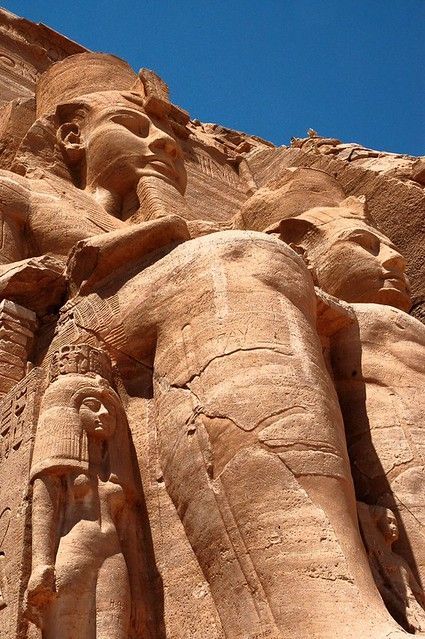
Abu Simbel is a historic site comprising two massive rock-cut temples in the village of Abu Simbel (Arabic: أبو سمبل), Aswan Governorate, Upper Egypt, ...
The twin temples were originally carved out of the mountainside in the 13th century BC, during the 19th Dynasty reign of the Pharaoh Ramesses II. They serve as a lasting monument to the king Ramesses II. His wife Nefertari and children can be seen in smaller figures by his feet, considered to be of lesser importance and were not given the same position of scale. This commemorates his victory at the Battle of Kadesh. Their huge external rock relief figures have become iconic.
The complex was relocated in its entirety in 1968 as part of the International Campaign to Save the Monuments of Nubia, under the supervision of a Polish archaeologist, Kazimierz Michałowski, from the Polish Centre of Mediterranean Archaeology University of Warsaw
234 notes
·
View notes
Text



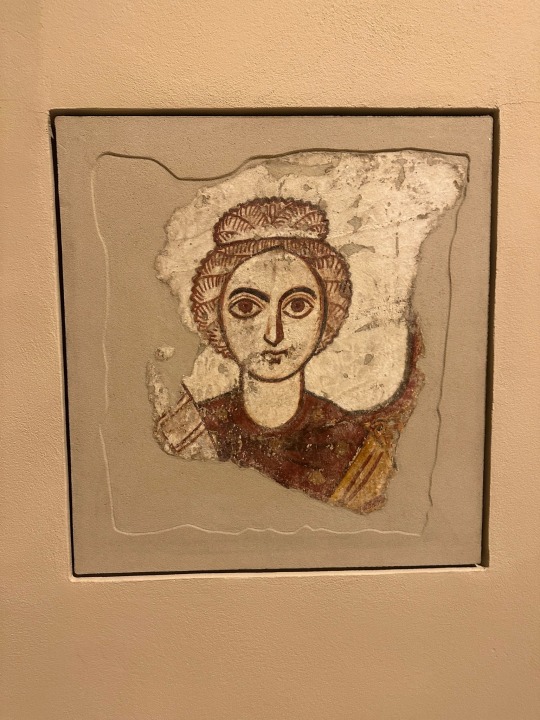


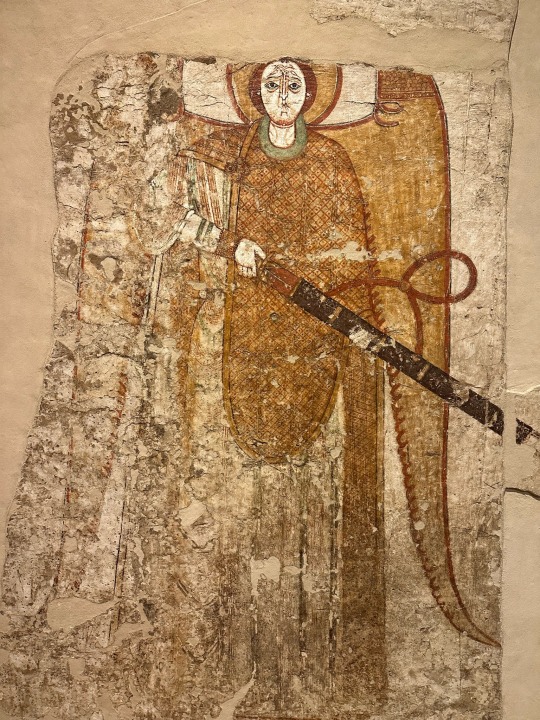

One of my favourite places - the Faras Gallery.
„Faras (formerly Ancient Greek: Παχώρας, Pakhôras; Latin: Pachoras; Old Nubian: Ⲡⲁⲭⲱⲣⲁⲥ, Pakhoras) was a major city in Lower Nubia. The site of the city, on the border between modern Egypt and Sudan at Wadi Halfa Salient, was flooded by Lake Nasser in the 1960s and is now permanently underwater. Before this flooding, extensive archaeological work was conducted by a Polish archaeological team led by professor Kazimierz Michałowski.”
„The cathedral was founded by bishop Aetios in 620 and then twice rebuilt: by Paulos at the beginning of the 8th century and Petros I at the end of the 10th century. The subsequent buildings were called after these bishops. The cathedral had been completely filled with sand thanks to which its structure and decoration were well preserved. These paintings are the best surviving examples of Christian Nubian art and depict portraits of archangels, mainly Michael, various monarchs and bishops of Faras, Christian saints, Virgin Mary and a number of Biblical scenes. They were executed in tempera on dry plaster, on several layers dated from the 8th to the 14th century. Of the 169 uncovered paintings, 120 were taken down from the walls. Sixty-six of them were transported to Poland and are today on display in the Polish National Museum in Warsaw, and in Sudan National Museum in Khartoum. In addition, a major pottery workshop was found.
Thanks to the discovery of the List of Bishops of Faras, it was possible to date each episcopate and thus to establish the date of some of the wall paintings.
In the turbulent later years of Christian Nubia, Faras seems to have declined and the administrative centre moved to the more easily defended area of Qasr Ibrim.”
(From wikipedia: https://en.wikipedia.org/wiki/Faras)
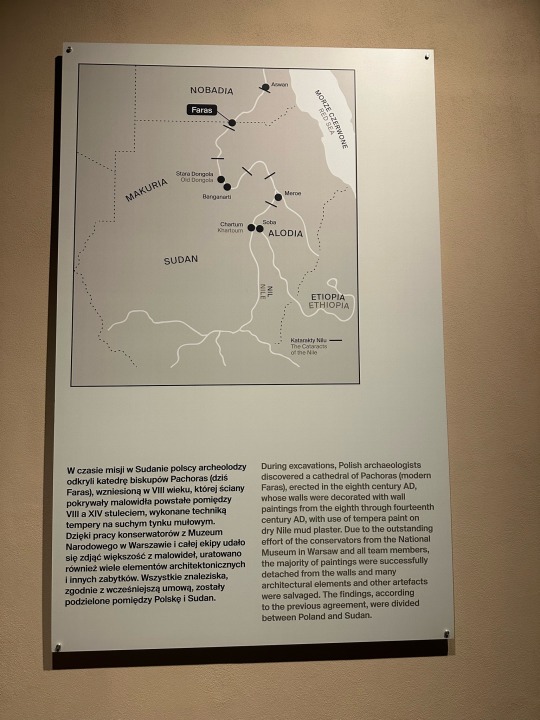

12 notes
·
View notes
Photo
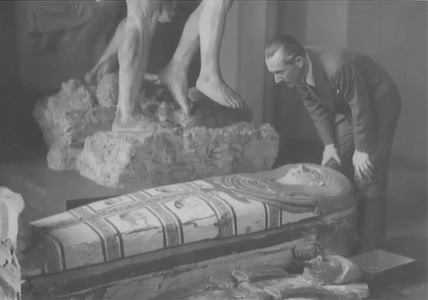
Polish archeologist Kazimierz Michałowski admiring sarcophagus (1937; collection of National Museum of Warsaw)
#archeology#polish archeology#kazimierz michałowski#kazimierz michalowski#1930s#20th century#old photography#national museum of warsaw
9 notes
·
View notes
Text
NUOVE SCOPERTE DAL TEMPIO DI HATSHEPSUT, TEBE OVEST, EGITTO
NUOVE SCOPERTE DAL TEMPIO DI HATSHEPSUT, TEBE OVEST, EGITTO
27, a Deir el-Bahari, sulla riva occidentale del Nilo, in Egitto.
Le missioni archeologiche polacche proseguono nel Tempio di Hatshepsut dal 1961, quando il prof. Kazimierz Michałowski istituì la spedizione archeologica e di conservazione polacco-egiziana. Da allora, archeologi, conservatori e architetti associati al Centro di Archeologia del Mediterraneo (CAŚ) dell’Università di Varsavia hanno…
View On WordPress
#Cappella Rossa di Hatshepsut#Hatshepsut#Kazimierz Michałowski#Patryk Chudzik#Tebe Ovest#Tempio di Hatshepsut#Università di Varsavia#Ushabti
0 notes
Photo


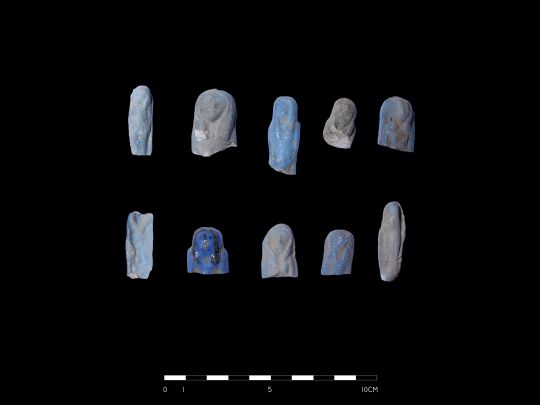




Ancient Egyptian ‘Garbage Dump’ Reveals Hundreds of Artifacts
Figurines of deities and priests as well as vessels with a breast motif are among several hundred items discovered by archaeologists at an ancient garbage dump in Egypt.
Polish researchers at the Temple of Hatshepsut in Luxor in the south of the country, came across the extraordinary find while working on the reconstruction of the 3,500-year-old Chapel of the Goddess Hathor.
Exploring a tomb carved into the rock face, the team from the Polish Centre of Mediterranean Archaeology first came across the rubbish dump.
Head of research Dr. Patryk Chudzik said: “We were concerned that our work could lead to the collapse of the tomb ceiling, which is why we wanted to secure it.
“After entering we found that it had never been studied and cleaned, because the debris stacked up to a height of about half a meter.”
Buried within the rubble they came across the ancient artifacts.
Chudzik said: “The amount and quality of the artifacts we have found is astounding. They include a wooden figurine most likely depicting the owner of the tomb with a wig on his head.”
Other items discovered included dozens of women figurines, as well as ceramic flasks with breast motifs and floral patterns symbolizing the rebirth of the Land of the Dead, and cow figurines from the early 18th dynasty, the period of the New Kingdom.
According to Dr. Chudzik, these were offerings to the Egyptian Goddess Hathor.
He said: “The offerings were made by local residents asking Hathor for support. After a while, there were too many of them and priests and temple staff had to clear them.
“We have already known a few places right at the temple entrance gates, where they were disposed of. Now we have discovered another, previously unknown place.”
The tomb was originally discovered in the late 19th century by Professor Henri Édouard Naville. However, the information he published about it was quite scarce. The researcher mentioned the rubble filling the tomb, but did not mention any excavations conducted in this place.
Archaeologists from an American expedition working at the Temple of Hatshepsut in 1920s also missed this precious rubble.
It appears that the rubble with votive offerings to Hathor remained intact since the time of the deposit, almost 3,500 years ago.
Polish researchers have been working at the Temple of Hatshepsut since 1961, when Professor Kazimierz Michałowski founded Polish-Egyptian Archaeology and Conservation Expedition.
Since then, archaeologists, restorers and architects associated with the Polish Centre of Mediterranean Archaeology have been working on documentation and reconstruction of the temple. Currently, their efforts are focused on rebuilding the Hathor shrine. Partly underneath it there is a tomb carved the rock, which they recently explored.
The tomb is carved in the rock. It consists of a passage more than 15 meters long which leads to a chamber with a recess in the stone floor where the coffin with the body of the owner of the tomb was originally placed.
The discovery was made and research carried out in the spring of 2021. This season, the experts intend to support the ceiling of the tomb to enable reconstruction work in the Hathor shrine located above it.
By Szymon Zdziebłowski.
#Ancient Egyptian ‘Garbage Dump’ Reveals Hundreds of Artifacts#archeology#Temple of Hatshepsut in Luxor#Chapel of the Goddess Hathor#Egyptian Goddess Hathor#ancient tomb#ancient grave#history#history news#ancient history#ancient civilizations#Egyptian civilization#Egyptian history
34 notes
·
View notes
Photo

The Mortuary Temple of Hatshepsut, also known as the Djeser-Djeseru (Ancient Egyptian: ḏsr ḏsrw "Holy of Holies"), is a mortuary temple of Ancient Egypt located in Upper Egypt. 🕌📸🍀 Polish-Egyptian Archaeological and Conservation Mission at the Temple of Hatshepsut at Deir el-Bahari was established in 1961 by Prof. Kazimierz Michałowski, who also became its first director. Since then, archaeologists, conservators, architects, and other specialists have been working under the auspices of the Polish Centre of Mediterranean Archaeology University of Warsaw (PCMA UW), and in cooperation with the Egyptian Ministry of Antiquities, on documenting and reconstructing the temple. Polish specialists are responsible for the study and restoration of the three levels of the temple. During work on the Upper Terrace, graves of members of the royal families from the Twenty-second to the Twenty-sixth Dynasties were discovered. The necropolis was created after the terrace had been destroyed by an earthquake. The archaeological and conservation expedition reconstructed almost the entire Upper Terrace, including nine statues of Hatshepsut as Osiris, the so-called Osiriacs. The temple is gradually being opened for tourists. Since 2000, they can visit the reconstructed Upper Festival Courtyard, the so-called Coronation Portico, and the platform of the Upper Ramp. In 2015 and 2017, the Solar Cult Complex and the Main Sanctuary of Amun-Re, respectively, were also opened to the public. The Polish team consists of specialists from many scientific institutions: the Polish Centre of Mediterranean Archaeology University of Warsaw, the Institute of Mediterranean and Oriental Cultures of the Polish Academy of Sciences, the National Museum in Warsaw, and the Faculty of Architecture of the Wrocław University of Science and Technology. Since 2020, the project is directed by Patryk Chudzik from the PCMA UW. #Travel #TravelPics #Photography #TravelPhoto #Podroze #Wycieczka #Zdjecia #egypt #luxor #visitegypt #visitegypt🇪🇬 #visitluxor #visitthebes #spring #Sun #Fun #Follow #FollowMe #FollowThem #Walk #Walking #egyptpolish #mortuarytempleofqueenhatshepsut (w: Mortuary Temple of Hatshepsut) https://www.instagram.com/p/COkZC2VN6hm/?igshid=znxerjr3pb4y
#travel#travelpics#photography#travelphoto#podroze#wycieczka#zdjecia#egypt#luxor#visitegypt#visitegypt🇪🇬#visitluxor#visitthebes#spring#sun#fun#follow#followme#followthem#walk#walking#egyptpolish#mortuarytempleofqueenhatshepsut
9 notes
·
View notes
Photo



December 30, 2019 | I’m reading Agatha Christie’s Death on the Nile (1937). It’s likely very obvious that this story is mostly set on Egypt’s Nile. The places visited and the experiences experienced (murder aside) are very much what a tourist may experience in Egypt today: taking a cruise ship or felucca up the Nile (I doubt there’s a steamer to be had nowadays), from Aswan (or Assuan, as is written in the book; located close to the Sudanese border) to Luxor, or thereabouts.
Of the various covers of Death of the Nile, my favourite is the the leftmost one, which I am assuming features Ramses II and Ramses II at Abu Simbel (yes, both statues are of himself if this is the temple of which I am thinking). When Agatha Christie saw it (which I suspect she did?), the temple was in its original position; however, the temple was “relocated in its entirety in 1968 under the supervision of the Polish archaeologist Kazimierz Michałowski” lest it be submerged/ruined by flooding with the building of the Aswan High Dam, which was built between 1960 and 1970. [source]
#l'egypte est partout#egypt#agatha christie#death on the nile#nile#abu simbel#aswan high dam#ramses ii#egypt in books
1 note
·
View note
Photo

The complex is part of the UNESCO World Heritage Site known as the "Nubian Monuments", which run from Abu Simbel downriver to Philae (near Aswan). The twin temples were originally carved out of the mountainside in the 13th century BC, during the 19th Dynasty reign of the Pharaoh Ramesses II. They serve as a lasting monument to the king Ramesses II. His wife Nefertari and children can be seen in smaller figures by his feet, considered to be of lesser importance and were not given the same position of scale. This commemorates his victory at the Battle of Kadesh. Their huge external rock relief figures have become iconic. The complex was relocated in its entirety in 1968 under the supervision of a Polish archaeologist, Kazimierz Michałowski, from the Polish Centre of Mediterranean Archaeology University of Warsaw, on an artificial hill made from a domed structure, high above the Aswan High Dam reservoir. The relocation of the temples was necessary or they would have been submerged during the creation of Lake Nasser, the massive artificial water reservoir formed after the building of the Aswan High Dam on the River Nile. The project was carried out as part of the UNESCO Nubian Salvage Campaign. #unesco #history #archaeology #archaeologist #ancient #archeologia #travel #ancientcity #discovery #follow #archeological #instalikes #instagood #amazing #likes #nice #photooftheday #travelingram #tourism #travelgram #instagram #bestoftheday #photoohistory #NYC #usa #археология #amazingplace #igersitalia #viagg #newyork (Abu Simbel, Aswan, Egypt) https://www.instagram.com/p/CVS65n8M-DF/?utm_medium=tumblr
#unesco#history#archaeology#archaeologist#ancient#archeologia#travel#ancientcity#discovery#follow#archeological#instalikes#instagood#amazing#likes#nice#photooftheday#travelingram#tourism#travelgram#instagram#bestoftheday#photoohistory#nyc#usa#археология#amazingplace#igersitalia#viagg#newyork
1 note
·
View note
Text
Encuentran en Sudán los restos de una catedral medieval nubia con pinturas murales
Los arqueólogos que trabajan en la antigua Dongola (Sudán) encontraron los restos de la que puede ser la mayor iglesia conocida de la Nubia medieval. Podría haber sido la sede de un arzobispo que gobernaba la jerarquía eclesiástica en un tramo de 1.000 km a lo largo del Nilo, entre la primera y la quinta catarata. El arzobispo de Dongola supervisaba al obispo de Faras, cuya catedral con sus famosas pinturas murales fue descubierta por el profesor Kazimierz Michałowski hace 60 años.
etiquetas: encuentran, sudán, restos, catedral, medieval, nubia, murales, pintura
» noticia original (www.labrujulaverde.com)
0 notes
Photo

This is Abu Simbel temples, in Egypt 🇪🇬 ———————————— They are two massive rock temples at Abu Simbel, a village in Nubia, Upper Egypt, near the border with Sudan. They are situated on the western bank of Lake Nasser, about 230 km southwest of Aswan . The complex is part of the UNESCO World Heritage Site known as the "Nubian Monuments", which run from Abu Simbel downriver to Philae (near Aswan). The twin temples were originally carved out of the mountainside in the 13th century BC, during the 19th dynasty reign of the Pharaoh Ramesses II. They serve as a lasting monument to the king and his queen Nefertari, and commemorate his victory at the Battle of Kadesh. Their huge external rock relief figures have become iconic. ———————————— The complex was relocated in its entirety in 1968 under the supervision of a Polish archaeologist, Kazimierz Michałowski, on an artificial hill made from a domed structure, high above the Aswan High Dam reservoir. The relocation of the temples was necessary or they would have been submerged during the creation of Lake Nasser, the massive artificial water reservoir formed after the building of the Aswan High Dam on the Nile River. ———————————— ✅With the passage of time, the temples fell into disuse and eventually became covered by sand. By the 6th century BC, the sand already covered the statues of the main temple up to their knees. The temple was forgotten until 1813, when Swiss orientalist Jean-Louis Burckhardt found the top frieze of the main temple. #abusimbel #egypt #africa #earthguideofficial #facts #travel #traveladdict #wanderlust (at Abu Simbel, Aswan, Egypt) https://www.instagram.com/p/BxfKOhgnaMP/?igshid=86vlv5ovr6bz
0 notes
Photo






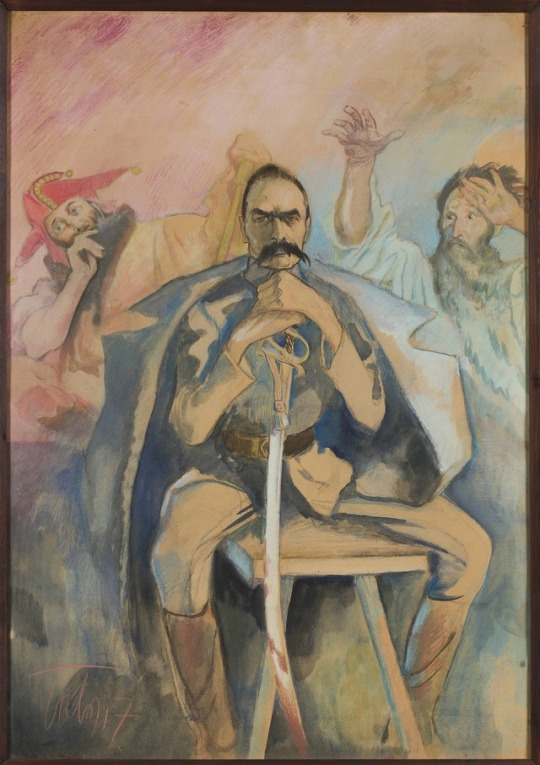
JAN MATEJKO Rejtan- Upadek Polski
MARCELLO BACCIARELLI Nadanie Konstytucji Księstwu Warszawskiemu przez Napoleona
PIOTR MICHAŁOWSKI Somosierra
HORACE VERNET Polski Prometeusz
ARTUR GROTTGER Pożegnanie Powstańca
MAKSYMILIAN GIERYMSKI Patrol Powstańczy
KAZIMIERZ SICHULSKI Piłsudski ze Stańczykiem i Wernyhorą
> Obrazy przedstawiające ważne wydarzenia związane z historią Polski w latach 1795-1918 będą częścią animacji.
0 notes
Photo

The National Museum in Warsaw, popularly abbreviated as MNW, is a national museum in Warsaw, one of the largest museums in Poland and the largest in the capital. It comprises a rich collection of ancient art (Egyptian, Greek, Roman), counting about 11,000 pieces, an extensive gallery of Polish painting since the 16th century and a collection of foreign painting (Italian, French, Flemish, Dutch, German and Russian) including some paintings from Adolf Hitler’s private collection, ceded to the Museum by the American authorities in post-war Germany. The museum is also home to numismatic collections, a gallery of applied arts and a department of oriental art, with the largest collection of Chinese art in Poland, comprising some 5,000 objects.
The Museum boasts the Faras Gallery with Europe’s largest collection of Nubian Christian art and the Gallery of Medieval Art with artefacts from all regions historically associated with Poland, supplemented by selected works created in other regions of Europe.
From medieval African masters to Botticelli, Rembrandt and Picasso, from Egyptian mummies to the most important examples of Polish design, from sacral art to Natalia LL’s feminist Consumer Art… The National Museum in Warsaw is much more than just masterpieces known from school textbooks, although Jan Matejko’s The Battle of Grunwald, Józef Chełmoński’s Storks or Strange Garden by Józef Mehoffer occupy an important place in the collection, which today boasts over 830 thousand works.
var quads_screen_width = document.body.clientWidth; if ( quads_screen_width >= 1140 ) { /* desktop monitors */ document.write('<ins class="adsbygoogle" style="display:inline-block;width:468px;height:60px;" data-ad-client="pub-9117077712236756" data-ad-slot="9839843423" >'); (adsbygoogle = window.adsbygoogle || []).push({}); }if ( quads_screen_width >= 1024 && quads_screen_width < 1140 ) { /* tablet landscape */ document.write('<ins class="adsbygoogle" style="display:inline-block;width:468px;height:60px;" data-ad-client="pub-9117077712236756" data-ad-slot="9839843423" >'); (adsbygoogle = window.adsbygoogle || []).push({}); }if ( quads_screen_width >= 768 && quads_screen_width < 1024 ) { /* tablet portrait */ document.write('<ins class="adsbygoogle" style="display:inline-block;width:468px;height:60px;" data-ad-client="pub-9117077712236756" data-ad-slot="9839843423" >'); (adsbygoogle = window.adsbygoogle || []).push({}); }if ( quads_screen_width < 768 ) { /* phone */ document.write('<ins class="adsbygoogle" style="display:inline-block;width:468px;height:60px;" data-ad-client="pub-9117077712236756" data-ad-slot="9839843423" >'); (adsbygoogle = window.adsbygoogle || []).push({}); }
The most important of them – representing not just painting or sculpture, but also photography and new media art – are presented in the modernist building located in the centre of Warsaw as well as online, on the Digital NMW website.
The Museum has four branches: the Poster Museum at Wilanów, the Xawery Dunikowski Museum of Sculpture at the Królikarnia Palace (Warsaw), the Museum of Interiors in Otwock Wielki and the Radziwiłł Palace in Nieborów and Romantic Park in Arkadia. They are located in splendid mansions surrounded by picturesque parks.
Since 2012 – the year marking the 150th anniversary of the NMW – subsequent permanent galleries are being thoroughly rearranged in order to present the most valuable works in a modern and friendly setting.
The refurbished Prof. Kazimierz Michałowski’s Faras Gallery was honoured with a number of awards, such as the Grand Prix of the Sybilla 2014 competition for the museum event of the year. The Faras Gallery is the only European exhibition of early Christian Nubian painting.
In it, treasures of a civilization that blossomed over 1500 years ago are accompanied by multimedia exhibits, including a 3D film projection.
The Gallery of Medieval Art offers the most diverse showcase of the artistic heritage of this era in Poland.
The Gallery of 19th Century Art presents flagship works by Polish artists in the context of their European counterparts. The Gallery of 20th and 21st Century Art is the only Warsaw-based display of the artistic output of the last century of that magnitude and calibre.
The new permanent galleries are going to showcase European and Old Polish craft, painting and sculpture (Gallery of Old Art), masterpieces of antiquity (the newly refurbished Gallery of Ancient Art) and the icons of Polish design (Gallery of Design).
The National Museum Warsaw, Poland was originally published on HiSoUR Art Collection
0 notes
Photo

The Mortuary Temple of Hatshepsut, also known as the Djeser-Djeseru (Ancient Egyptian: ḏsr ḏsrw "Holy of Holies"), is a mortuary temple of Ancient Egypt located in Upper Egypt. Built for the Eighteenth Dynasty pharaoh Hatshepsut, who died in 1458 BC, the temple is located beneath the cliffs at Deir el-Bahari on the west bank of the Nile near the Valley of the Kings 🕌📸🍀 Polish-Egyptian Archaeological and Conservation Mission at the Temple of Hatshepsut at Deir el-Bahari was established in 1961 by Prof. Kazimierz Michałowski, who also became its first director. Since then, archaeologists, conservators, architects, and other specialists have been working under the auspices of the Polish Centre of Mediterranean Archaeology University of Warsaw (PCMA UW), and in cooperation with the Egyptian Ministry of Antiquities, on documenting and reconstructing the temple. Polish specialists are responsible for the study and restoration of the three levels of the temple.[6] During work on the Upper Terrace, graves of members of the royal families from the Twenty-second to the Twenty-sixth Dynasties were discovered. The necropolis was created after the terrace had been destroyed by an earthquake. The archaeological and conservation expedition reconstructed almost the entire Upper Terrace, including nine statues of Hatshepsut as Osiris, the so-called Osiriacs. The temple is gradually being opened for tourists. Since 2000, they can visit the reconstructed Upper Festival Courtyard, the so-called Coronation Portico, and the platform of the Upper Ramp. In 2015 and 2017, the Solar Cult Complex and the Main Sanctuary of Amun-Re, respectively, were also opened to the public. The Polish team consists of specialists from many scientific institutions: the Polish Centre of Mediterranean Archaeology University of Warsaw. #Travel #TravelPics #Photography #TravelPhoto #Podroze #Wycieczka #Zdjecia #egypt #luxor #visitegypt #visitegypt🇪🇬 #visitluxor #visitthebes #spring #Sun #Fun #Follow #FollowMe #FollowThem #Walk #Walking #hatshepsut #hatshepsuttemple #hatshepsuttempleluxor #themortuarytempleofqueenhatshepsut #themortuarytempleofhatshepsut (w: Mortuary Temple of Hatshepsut) https://www.instagram.com/p/COm5eFmNqK_/?igshid=1mtwue0ny3ye0
#travel#travelpics#photography#travelphoto#podroze#wycieczka#zdjecia#egypt#luxor#visitegypt#visitegypt🇪🇬#visitluxor#visitthebes#spring#sun#fun#follow#followme#followthem#walk#walking#hatshepsut#hatshepsuttemple#hatshepsuttempleluxor#themortuarytempleofqueenhatshepsut#themortuarytempleofhatshepsut
0 notes
Photo

Portrait of Ignacy Jan Paderewski
Lawrence Alma-Tadema 1890
From the collection of
The National Museum in Warsaw
This painting depicts Ignacy Paderewski, a world-renowned pianist and composer and the Prime Minister of Poland in 1919. It was painted in London in 1891, during the pianist’s first tour of England. One of Paderewski’s private concerts took place in the home of the Dutch painter Lawrence Alma-Tadema, who had settled permanently in England and enjoyed tremendous popularity in the Victorian and Edwardian periods. It was there that this exceptional portrait was painted.
The artist presents Paderewski against a backdrop composed of two colour fields, an orange-yellow Japanese textile and wood panelling of a uniform, dark-olive colour. Alma-Tadema was an expert on and collector of Japanese art. He was known to be enamoured with Japanese woodcuts already during his first visit to London in 1872, and twenty years later he became a member of the Japan Society, whose mandate was to promote Japanese art and culture. Coincidentally, the subject of the portrait also nurtured a fascination with Far Eastern culture. While on tour, Paderewski amassed a rich collection of Japanese and Chinese art, which he would later bequeath to the National Museum in Warsaw.
Inscribed in the upper right corner, next to the artist’s signature, we notice a designation associated with music – OP, along with the number 311 written in Roman numerals. This is explained by the fact that Alma-Tadema liked to number his works in the way that composers do.
Details
Title: Portrait of Ignacy Jan Paderewski
Creator: Lawrence Alma-Tadema
Date: 1890
Physical Dimensions: w59 x h45.5 cm
Inv. no.: M.Ob.1850 NMW
Type: Paintings
External Link: Digital National Museum in Warsaw http://cyfrowe.mnw.art.pl/dmuseion/docmetadata?id=15677&show_nav=true
Medium: oil on canvas
The Walters Art Museum
Baltimore, United States
The Walters Art Museum is one of only a few museums in the world to present a panorama of art from the third millennium B.C. to the early 20th century. The thousands of treasures range from mummies to arms and armor, from old master paintings to Art Nouveau jewelry. The Walters’ Egyptian, Greek, Roman, Byzantine, Ethiopian and Western Medieval art collections are among the finest in the nation, as are the museum’s holdings of Renaissance and Asian art and a spectacular reserve of illuminated manuscripts and rare books. Every major trend in French painting during the 19th century is represented in the collection.
The National Museum in Warsaw
Warszawa, Poland
From medieval African masters to Botticelli, Rembrandt and Picasso, from Egyptian mummies to the most important examples of Polish design, from sacral art to Natalia LL’s feminist Consumer Art… The National Museum in Warsaw is much more than just masterpieces known from school textbooks, although Jan Matejko’s The Battle of Grunwald, Józef Chełmoński’s Storks or Strange Garden by Józef Mehoffer occupy an important place in the collection, which today boasts over 830 thousand works.
The most important of them – representing not just painting or sculpture, but also photography and new media art – are presented in the modernist building located in the centre of Warsaw as well as online, on the Digital NMW website.
The Museum has four branches: the Poster Museum at Wilanów, the Xawery Dunikowski Museum of Sculpture at the Królikarnia Palace (Warsaw), the Museum of Interiors in Otwock Wielki and the Radziwiłł Palace in Nieborów and Romantic Park in Arkadia. They are located in splendid mansions surrounded by picturesque parks.
Since 2012 – the year marking the 150th anniversary of the NMW – subsequent permanent galleries are being thoroughly rearranged in order to present the most valuable works in a modern and friendly setting.
The refurbished Prof. Kazimierz Michałowski’s Faras Gallery was honoured with a number of awards, such as the Grand Prix of the Sybilla 2014 competition for the museum event of the year. The Faras Gallery is the only European exhibition of early Christian Nubian painting.
In it, treasures of a civilization that blossomed over 1500 years ago are accompanied by multimedia exhibits, including a 3D film projection.
The Gallery of Medieval Art offers the most diverse showcase of the artistic heritage of this era in Poland.
The Gallery of 19th Century Art presents flagship works by Polish artists in the context of their European counterparts. The Gallery of 20th and 21st Century Art is the only Warsaw-based display of the artistic output of the last century of that magnitude and calibre.
The new permanent galleries are going to showcase European and Old Polish craft, painting and sculpture (Gallery of Old Art), masterpieces of antiquity (the newly refurbished Gallery of Ancient Art) and the icons of Polish design (Gallery of Design).
Lawrence Alma-Tadema
Jan 8, 1836 – Jun 25, 1912
Sir Lawrence Alma-Tadema, OM, RA was a Frisian painter of special British denizenship.
Born in Dronrijp, the Netherlands, and trained at the Royal Academy of Antwerp, Belgium, he settled in England in 1870 and spent the rest of his life there. A classical-subject painter, he became famous for his depictions of the luxury and decadence of the Roman Empire, with languorous figures set in fabulous marbled interiors or against a backdrop of dazzling blue Mediterranean Sea and sky.
Though admired during his lifetime for his draftsmanship and depictions of Classical antiquity, his work fell into disrepute after his death, and only since the 1960s has it been re-evaluated for its importance within nineteenth-century English art.
Portrait of Ignacy Jan Paderewski Lawrence Alma-Tadema 1890 was originally published on HiSoUR Art Collection
1 note
·
View note